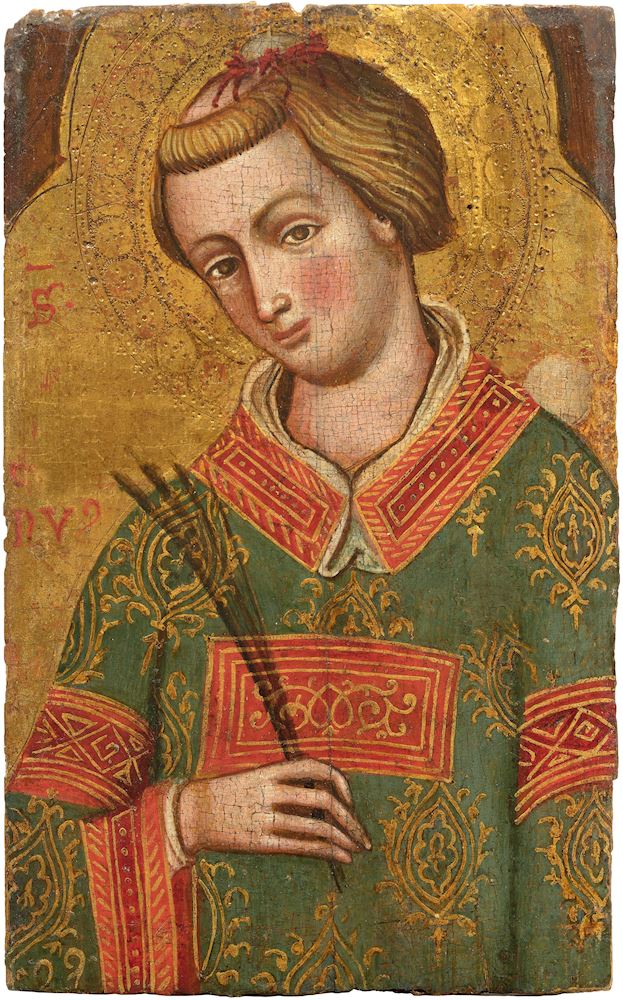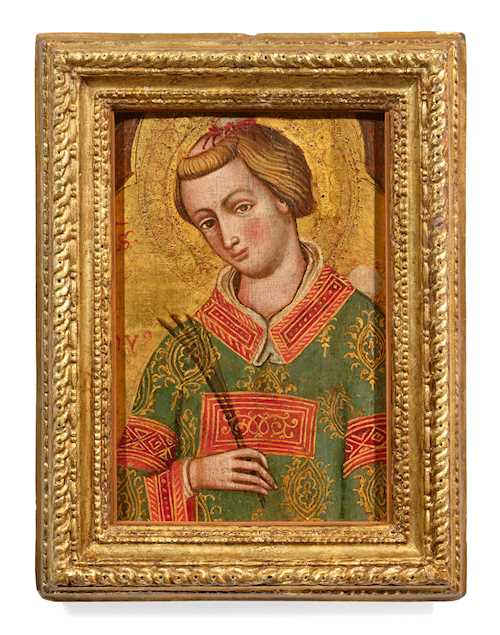
拍品 3001* - A206 大师画作 - Freitag, 22. September 2023, 02.00 PM
CATARINO DI MARCO DA VENEZIA
(before 1365 Venice 1390)
Saint Stephanus.
Tempera on panel.
30.5 × 19.5 cm.
Certificate:
Prof. Cristina Guarnieri, 20.2.2021.
Provenance:
European private collection.
The painting depicts Saint Stephen, who elegantly inclines his head to the right, with an understanding gaze towards the viewer. In his hand he holds the martyr’s palm, while on his head and left shoulder are the stones indicating his martyrdom by stoning in Jerusalem (Acts of the Apostles, 6–7). Stephen is venerated as an archdeacon and arch-martyr, as he was the first Christian to give his life for the confession of his faith. Over his surplice he wears a green silk dalmatic with wide red embroidered bands. The cloth is decorated with golden motifs, a simplified version of the more sophisticated ornamentation current among artists during the first half of the century, and also employed by Lorenzo Veneziano (1336–1379) from the 1350s onwards. Much more complex is the well-preserved decoration of the halo, which is stamped freehand. Its design borrows elements from Lorenzo, but with different goldwork and much more elaborate motifs compared to the repetitive schemes used in Lorenzo's studio.
The panel comes from a larger ensemble, probably the right side of a polyptych, as Saint Stephen is slightly turned to the opposite side. Stylistically, the work seems to have been painted in the first five years of the 1370s, when the painter was influenced by the new Gothic style that Lorenzo Veneziano had imposed on painting in Venice. This can be seen in the smiling, friendly expression on his face and the affectionate way he holds the martyr’s palm in his hand. The panel was reduced in size and transformed into a devotional picture. The original context was the altar with the Coronation of the Virgin and Saints Lucia and Nicholas of Tolentino, now in the museum of the Gallerie dell’Accademia in Venice (inv. no. 702), acquired in 1902 by the Venetian collector Tommaso Mazzoli (see Sandra Moschini Marconi: Gallerie dell’Accademia di Venezia. Opere d'arte dei secoli XIV e XV, Rome 1955, pp. 7–8). Presumably, the altarpiece was not originally a triptych, but consisted of several panels, including at least two more saints on each side, surmounted by half-figures and a kymation in the upper section, forming an imposing composition. This thesis is supported not only by the similar stylistic execution of our panel with those in the museum of the Gallerie dell’Accademia, but also by certain details regarding the decoration of the vestments or the size and details of the gold hallmarks. The presence of a panel with the figure of Saint Stephen in the main section of the polyptych, together with Saint Nicholas of Tolentino and Saint Lucia, points to a Venetian church of the Augustinian Order as the original destination. The church of Santo Stefano, which was built in the late 13th and early 14th centuries by hermit monks on the Venetian campo of the same name in the vicinity of St Mark’s, seems the most likely place of origin. Catarino’s work may have been intended for the main altar or a side chapel of this building, which also houses the relics of Saint Stephen for the veneration of the faithful.
The Venetian painter Catarino di Marco da Venezia, called Catarino Veneziano was one of the most prolific Venetian painters of the second half of the 14th century. He was first mentioned is in a document dated 23 October 1365. Catarino probably trained first with Paolo Veneziano (1300–1365) and then mainly with Donato (active around 1348–1386), with whom he also apprenticed. Later, he gradually adopted technical solutions and compositional ideas from Lorenzo Veneziano.
Our thanks to Prof. Gaudenz Freuler who has examined the painting in the original and confirmed its authenticity.
Prof. Cristina Guarnieri, 20.2.2021.
Provenance:
European private collection.
The painting depicts Saint Stephen, who elegantly inclines his head to the right, with an understanding gaze towards the viewer. In his hand he holds the martyr’s palm, while on his head and left shoulder are the stones indicating his martyrdom by stoning in Jerusalem (Acts of the Apostles, 6–7). Stephen is venerated as an archdeacon and arch-martyr, as he was the first Christian to give his life for the confession of his faith. Over his surplice he wears a green silk dalmatic with wide red embroidered bands. The cloth is decorated with golden motifs, a simplified version of the more sophisticated ornamentation current among artists during the first half of the century, and also employed by Lorenzo Veneziano (1336–1379) from the 1350s onwards. Much more complex is the well-preserved decoration of the halo, which is stamped freehand. Its design borrows elements from Lorenzo, but with different goldwork and much more elaborate motifs compared to the repetitive schemes used in Lorenzo's studio.
The panel comes from a larger ensemble, probably the right side of a polyptych, as Saint Stephen is slightly turned to the opposite side. Stylistically, the work seems to have been painted in the first five years of the 1370s, when the painter was influenced by the new Gothic style that Lorenzo Veneziano had imposed on painting in Venice. This can be seen in the smiling, friendly expression on his face and the affectionate way he holds the martyr’s palm in his hand. The panel was reduced in size and transformed into a devotional picture. The original context was the altar with the Coronation of the Virgin and Saints Lucia and Nicholas of Tolentino, now in the museum of the Gallerie dell’Accademia in Venice (inv. no. 702), acquired in 1902 by the Venetian collector Tommaso Mazzoli (see Sandra Moschini Marconi: Gallerie dell’Accademia di Venezia. Opere d'arte dei secoli XIV e XV, Rome 1955, pp. 7–8). Presumably, the altarpiece was not originally a triptych, but consisted of several panels, including at least two more saints on each side, surmounted by half-figures and a kymation in the upper section, forming an imposing composition. This thesis is supported not only by the similar stylistic execution of our panel with those in the museum of the Gallerie dell’Accademia, but also by certain details regarding the decoration of the vestments or the size and details of the gold hallmarks. The presence of a panel with the figure of Saint Stephen in the main section of the polyptych, together with Saint Nicholas of Tolentino and Saint Lucia, points to a Venetian church of the Augustinian Order as the original destination. The church of Santo Stefano, which was built in the late 13th and early 14th centuries by hermit monks on the Venetian campo of the same name in the vicinity of St Mark’s, seems the most likely place of origin. Catarino’s work may have been intended for the main altar or a side chapel of this building, which also houses the relics of Saint Stephen for the veneration of the faithful.
The Venetian painter Catarino di Marco da Venezia, called Catarino Veneziano was one of the most prolific Venetian painters of the second half of the 14th century. He was first mentioned is in a document dated 23 October 1365. Catarino probably trained first with Paolo Veneziano (1300–1365) and then mainly with Donato (active around 1348–1386), with whom he also apprenticed. Later, he gradually adopted technical solutions and compositional ideas from Lorenzo Veneziano.
Our thanks to Prof. Gaudenz Freuler who has examined the painting in the original and confirmed its authenticity.
CHF 20 000 / 30 000 | (€ 20 620 / 30 930)
以瑞士法郎銷售 CHF 25 000 (包含買家佣金)
所有信息随时可能更改。


